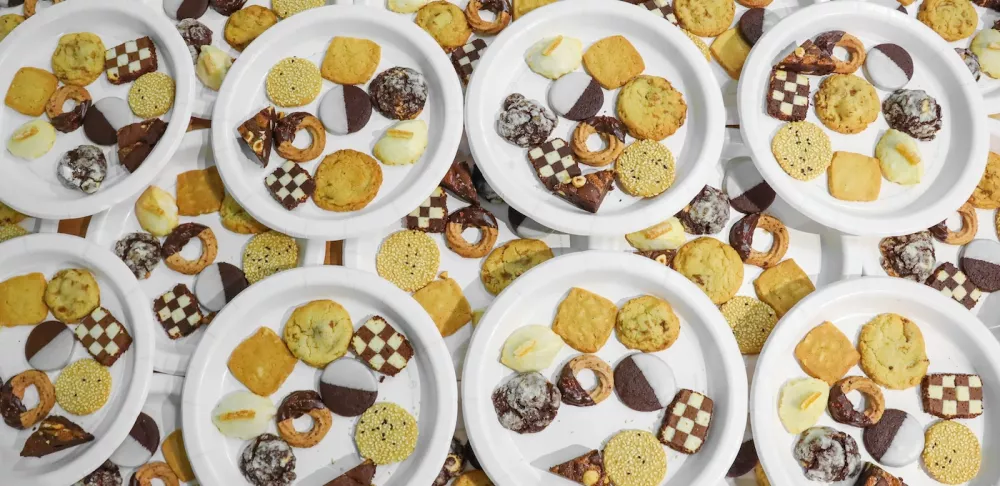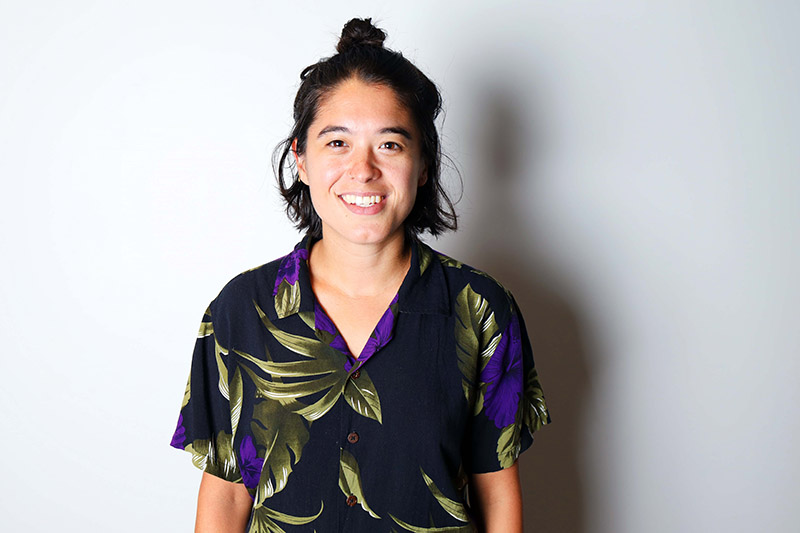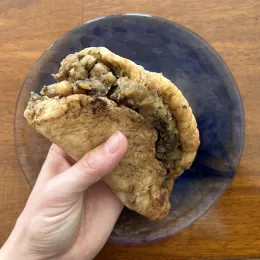To make holiday baking a little easier this year, Institute of Culinary Education Chef-Instructor Kierin Baldwin created three cookie dough bases that can be turned into nine (or more) different holiday cookies.
When it comes to holiday treats, Institute of Culinary Education Pastry & Baking Arts Chef-Instructor Kierin Baldwin knows that more is definitely more.
"Abundance and variety are two things I look for in a holiday cookie spread," Chef Kierin says.
However, she acknowledges that baking so many cookies can be time-consuming, even for a professional chef. At a recent demonstration at the Battery Park City Authority in New York City, Chef Kierin shared a shortcut for making an assortment of cookies for any holiday gathering.
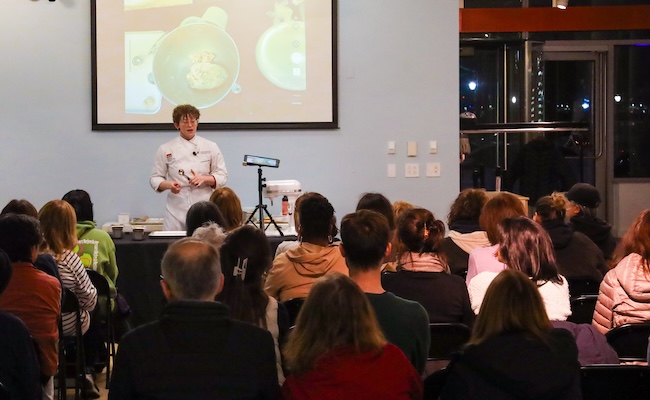
Chef Kierin demonstrated three cookie dough base recipes: a brown sugar cookie, a chocolate brownie, and a classic butter cookie, and followed with tips for easily making variations on each one. Then, by adjusting the flavor profile, mix-ins, shape and texture, she created three unique cookies with each dough, resulting in nine different cookies in total.
Read on for Chef Kierin’s tips for a creating a spectacular holiday cookie plate and get the recipes below.
The Science of a Cookie
When experimenting with cookie doughs, Chef Kierin says it’s important to know a few baking basics so you can predict how different ingredients will alter the final cookie. First, she explained the three basic types of cookie dough:
- Shortbread style – These cookies are crumbly, crisp, and buttery. They are tender and break apart easily in your mouth. The primary ingredient is butter.
- Sugar cookie dough – High in sugar, these cookies have a certain chewiness and can be crisp. Drop cookies and chocolate chip cookies are two examples of this dough type.
- Cake-based cookie – These are soft treats like whoopie pies and black and white cookies. This style of cookie is tender, springy and chewy. The lightness in the cookies comes from a high percentage of egg in the final recipe.
Chef Kierin also walked the audience through the different functions of each ingredient in a cookie.
“Baking ingredients serve multiple functions, so it’s important to know what each ingredient contributes in a recipe,” she says.
She explained that fat acts as a tenderizer while also adding flavor and helping the cookie spread on the pan. It also makes a cookie crisp and crumbly because it inhibits gluten formation.
Sugar also inhibits gluten development, acting as a tenderizer, and adds crispness to the end result.
Eggs add moisture and protein. The lecithin in egg yolks is a natural emulsifier, which helps bring the dough together. The protein in the egg white coagulates as the cookie bakes, providing structure.
Flour is the starch or gluten that provides structure; and lastly, chemical leaveners (like baking powder and baking soda) create texture by creating little pockets of air.
Take a deeper dive into the science of cookies with Chef-Instructor Stephen Chavez: Understanding the Science of Cookies
With these baking fundamentals in mind, Chef Kierin explained the techniques she used to tweak the base cookie dough recipes.
Mix-ins
After the cookie dough comes together, Chef Kierin suggested adding ingredients at this stage to transform the flavor. This can include extracts like vanilla, almond, peppermint, and strawberry. She also recommended incorporating spices, citrus juice or zest, chunks of dried fruit, nuts, miso, toffee, or tahini. One additional suggestion was praline paste, which is a smooth, thick paste made by finely grinding caramelized hazelnuts (or almonds). Chef Kierin’s Salted Praline Brownies have toasted hazelnuts incorporated into the batter, praline paste swirled into the top, and are sprinkled with finishing salt before baking.
Another idea Chef Kierin shared was substituting different flours, like buckwheat or wholewheat flour, or adding in multiple types – though she noted this would be done while making the base dough.
Shaping
Remember that saying, “You eat with your eyes first?” At the event, Chef Kierin remarked that having a variety of cookie shapes adds to the feeling of abundance on the dessert table.
She demonstrated a few methods for shaping cookie dough, which included rolling the dough into a log and slicing, piping, rolling the dough and using cookie cutters, and the crowd favorite, checkerboard cookies (which are much easier than you'd think!).
Once the cookies were shaped, Chef Kierin shared even more ways to customize them. Her Mocha Checkerboards, which utilize the butter cookie dough base, are brushed with egg white and then dredged in sanding sugar.
Cookie dough can be dipped into sesame seeds or sweetened cocoa nibs, a favorite of Chef Kierin’s.
Her Chocolate, Chocolate, Chocolate Chip Crinkles were tossed in granulated and powdered sugar before baking, which creates a cracked effect on the surface.
Baking Temperature
The temperature you set your oven to is yet another method you can use to riff on Chef Kierin’s cookie dough bases.
"Baking at a lower heat results in evenly baked cookies that are crisp and sharp," said Chef Kierin. Her Almond Crisps are baked at 325°F until evenly browned.
"A higher temperature produces a cookie that is crisp around the edges with a tender, chewy center," she added. An example here would be the Sesame Cookies, which are baked at 375°F until just barely browned at the edges.
Regarding bake time, you’ll see that Chef Kierin’s recipes don’t contain baking times or ranges. “When my students ask me how long to bake cookies or any other pastry, I tell them to bake it until it’s done. Every oven is different, and it’s more important to know what to look for rather than the time,” she said.
Chef Kierin’s clues for doneness are included in each recipe. They include what level of browning to look for (ranging from just barely to evenly browned) and where to look for it (at the edges or through the center). In other variations, these checks include whether the cookie springs back lightly to the touch and if they look fully set.
After Baking
Once the cookies are baked and out of the oven, you have another opportunity to alter their flavor and add visual appeal. Chef Kierin recommended dipping cookies in chocolate, brushing on glazes, and adding toppings.
Two variations of the butter cookie dough are manipulated after baking. The Pink Confetti Rosettes are dipped in dark chocolate and garnished with a sprinkle of ground pink peppercorn, and the Cornmeal Cookies are brushed with a citrus glaze and garnished with candied orange zest.
The options are endless, according to Chef Kierin.
Get the PDF with all of her base cookie dough recipes and variations by clicking here.
Then, use your favorite flavors and mix-ins to make these cookies your own, or try some of her suggestions below using the chocolate base dough. Happy baking!
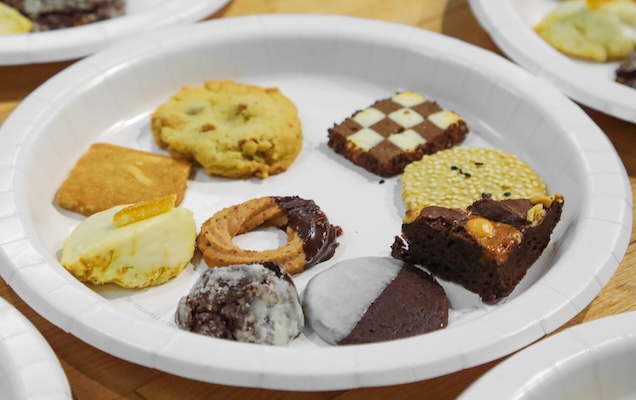
Chocolate Cookie Base & Variations: Salted Praline Brownies, Chocolate, Chocolate, Chocolate Chip Crinkles, and Minty Chocolate Wafers
The base recipe makes enough dough for one 9”x13” pan of brownies plus one batch of approximately two dozen cookies for each of the other two variations.

Ingredients
Chocolate Cookie Base:
460g bittersweet chocolate
175g unsweetened chocolate
175g unsalted butter
305g large eggs
405g granulated sugar
9g vanilla extract
3g salt
7g baking powder
90g all-purpose flour
Salted Praline Brownies:
900g chocolate cookie batter
75g praline paste
100g blanched hazelnuts, toasted
Finishing salt (such as Maldon or Fleur de Sel) to taste
Chocolate, Chocolate, Chocolate Chip Crinkles:
390g chocolate cookie batter
10g all-purpose flour
150g chocolate chunks or chips (can be a mix of dark, milk, and white chocolate)
Granulated sugar, as needed
Powdered sugar, as needed
Minty Chocolate Wafers:
335g chocolate cookie batter
10g all-purpose flour
2g peppermint extract
250g tempered white chocolate (optional)
Directions
Procedure for Chocolate Cookie Base:
- Combine the chocolate, unsweetened chocolate, and butter in a bowl and melt over a pot of boiling water.
- In the bowl of a stand mixer fitted with a whisk attachment, beat the eggs and sugar together for 5-10 minutes, or until light and aerated.
- Add the vanilla and whisk until combined.
- Add the melted chocolate mixture into the egg mixture all at once and then whisk to incorporate it completely. Scrape down the sides of the bowl to be sure it is evenly incorporated.
- In a separate bowl, combine the flour, baking powder, and salt. Gently fold the flour mixture into the chocolate-sugar mixture.
- Follow the directions below for each individual variation to make one pan of brownies and two dozen of each cookie.
Procedure for Salted Praline Brownies:
- Preheat an oven to 325°F.
- Prepare a 9x13-inch baking pan or a quarter sheet pan by coating it lightly with nonstick cooking spray and then lining the bottom with a piece of parchment.
- Fold about three-quarters of the toasted hazelnuts into the scaled quantity of batter and then spread it evenly on the prepared sheet.
- Spoon the praline paste over the top of the batter and then swirl it into the batter. Sprinkle the remaining hazelnuts over the top of the batter and then sprinkle the finishing salt over it to taste.
- Bake until the brownie has risen slightly and springs back when gently pressed in the center or a knife inserted in the center comes out clean.
Procedure for Chocolate, Chocolate, Chocolate Chip Crinkles:
- Preheat an oven to 350°F.
- Fold the flour into the scaled quantity of batter to fully incorporate and then fold in the chocolate chunks.
- Allow the batter to sit at room temperature just until it starts to firm up slightly and is no longer runny.
- Portion the batter using a #60 scoop and chill until firm.
- Coat the cookie dough in granulated sugar and then in powdered sugar and then place them on a baking sheet with plenty of room to spread.
- Bake until the sugar coating cracks and the cookies are just barely baked through in the center.
Procedure for Minty Chocolate Wafers:
- Add the flour to the scaled quantity of dough and mix until incorporated.
- Add the peppermint extract and mix until combined.
- Place the dough between two sheets of parchment and then roll out until an even ⅛ inch thick.
- Freeze the dough until firm.
- Preheat an oven to 325°F.
- Cut 1 ¾ inch circles from the dough and space them evenly on a flat baking sheet.
- Bake until cooked through and quite set in the center.
- Cool cookies completely and then dip in tempered white chocolate if desired.
Get the PDF for all of the cookie dough bases and recipes by clicking here.
If cookies aren't your dessert of choice, check out Chef Kierin's other recipes on our blog:



